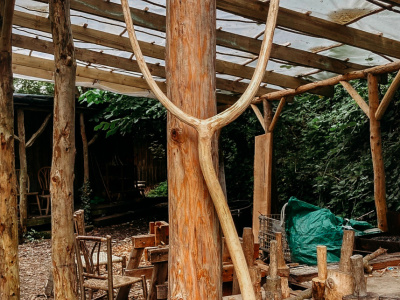
Rustic Rake Making
- The Green Wood Centre
- 02 Jun 2024
20 Meh 2022
June 20th-26th 2022 is Insect Week – an annual celebration encouraging people of all ages to appreciate and learn more about insects. We’re joining in the celebrations by shining a spotlight on 7 woodland insect species – check back each day this week to learn all about these fabulous beasties!
1. Oak bush cricket – Meconema thalassinum
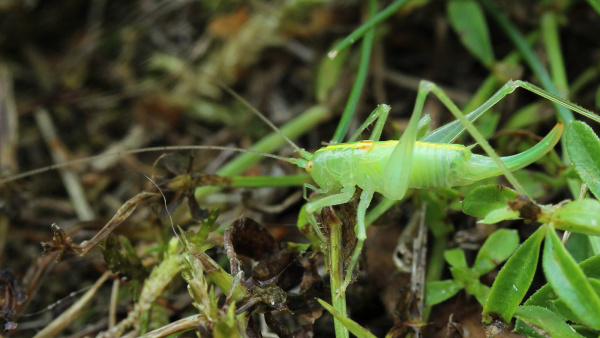
Above: An oak bush cricket walking across the ground. This cricket is a female as she has a long curved ovipositor at the end of her abdomen which she uses to lay eggs in crevices in bark or under moss or lichen. Image courtesy of user u278 on flickr.
Up in the treetops of deciduous woodland dwells this remarkable insect – the oak bush cricket. It is the UK’s only arboreal bush cricket, spending most of its time high up in the canopy of mature trees. As its name suggests, the oak bush cricket prefers oak woodland, but can be found on other deciduous trees and sometimes even in hedgerows. It is a commonly found in South Wales and central England and inhabits warm ancient woodland.
This cricket is unique from other UK species in a number of ways: firstly, unlike its vegetarian relatives, the oak bush cricket is largely carnivorous, feeding on a range of invertebrates including caterpillars and other insect larvae. Furthermore, while other cricket species are known for their chirping and singing, the oak bush cricket doesn’t have a call. It does, however, still use sound to communicate – during the mating season, males drum on leaves with their hind legs to attract females, though this sound is almost undetectable by humans.
Bush crickets, also known as katydids, are related to grasshoppers, but have much longer antennae and legs, preferring to walk instead of jump to get around, and the oak bush cricket is also an accomplished flier!
2. Speckled wood butterfly – Parage aegeria
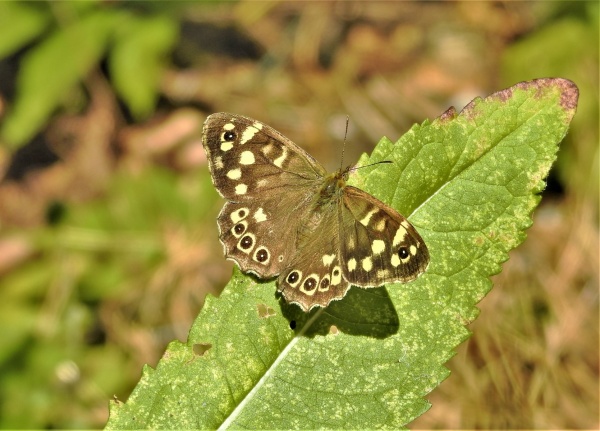
Above: A speckled wood butterfly resting on a leaf. Image courtesy of user Bob Silver on flickr.
The speckled wood, also known as the Enfield eye butterfly or the wood argus is a beautiful brown butterfly with cream colored spots on its forewings and a row of small eye-spots on its hind wings. They’re often found in open, sun-dappled woodland, where they feed primarily on honeydew – a sweet substance secreted by aphids, though they have been known to feed on flowers and fruit later in the year when aphid activity is low.
Male speckled woods are fiercely territorial and will aggressively defend their patch of woodland if another male ventures in. Males can often be seen spiralling through the canopy, trying to win over the best patches to attract a mate. Unlike some other butterfly species, females of the specked wood only mate once, so they are very choosy, and a good territory is a sure indication of a top-quality mate.
After mating, the female will lay her eggs on the caterpillar foodplant; speckled wood caterpillars eat a variety of grasses including false brome, Yorkshire fog and common couch. The caterpillars are well camouflaged amongst the grass, being bright green with faint darker green and yellow stripes down the length of their bodies. Every year there are several overlapping generations of speckled wood, and this species is able to hibernate either as a caterpillar or a chrysalis, emerging the following spring.
3. Woodland dor beetle – Anoplotrupes stercorosus
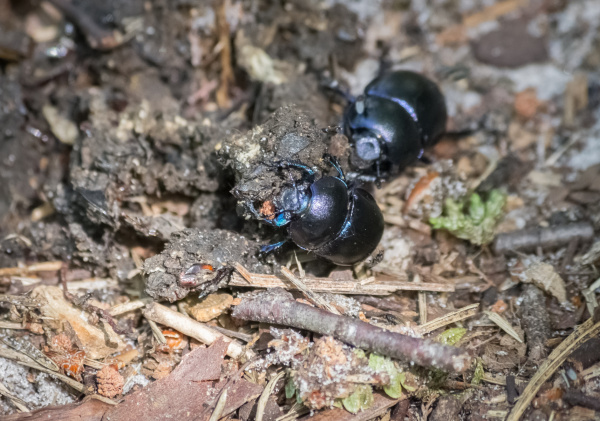
Above: Two woodland dor beetles on the forest floor, inspecting some pieces of dung. Image courtesy of user Nicolas Venner on flickr.
A vital member of nature’s cleaning crew, the woodland dor beetle is an earth-boring dung beetle that plays an important role in recycling herbivore dung.
Adults of this species endure the winter in burrows, emerging early in the year. After mating, females will create a new burrow, 20-50cm below a dung pile, and will lay their eggs directly into dung pellets kept in special brood chambers. The larvae will subsist entirely on the dung until they are ready to pupate and become adults themselves. Although adults do eat some dung, they are also known to feed on fungi, carrion, decaying plant matter, tree sap, and a range of other food sources, making them able to survive even when one food source is scarce.
One of our larger beetles at up to 19mm, the woodland dor beetle is widespread throughout England, Scotland and Wales and can be found in damp deciduous and mixed woodland. They are dependent on wild populations of deer as an important food source, but with the adults being such generalist feeders, they can endure dung scarcity better than other dung beetle species.
4. Drab wood-soldierfly – Solva marginata
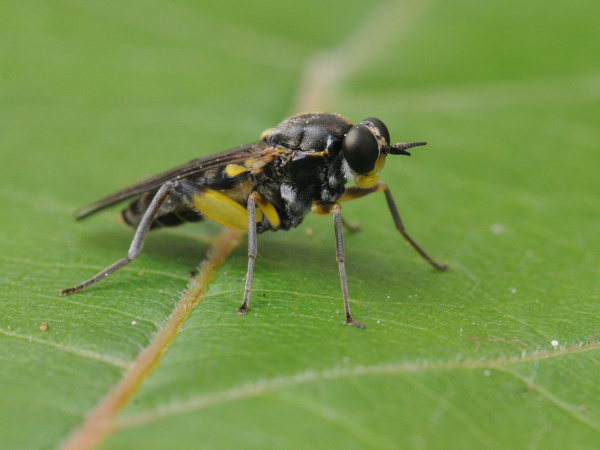
Above: A drab wood-soldierfly. Image courtesy of user Tim Worfolk on flickr.
Although named drab, when you look closely at the drab wood-soldierfly it is quite an attractive beast, with bright yellow thighs and little patches of delicate white hairs. Although it looks similar to a sawfly, which are related to wasps, this species is a true fly – a member of the order diptera, characterised by its sucking mouthparts and its single pair of wings.
The drab wood-soldierfly is reliant on decaying wood, occurring only in association with old and recently fallen trees and log piles. This is because the larvae, which can be found under bark of rotting trees, depend on decaying wood for their diet, preferring that of poplar or willow trees. The species is widespread but localised, occurring in woodland and at sites with scattered riverside trees.
5. Forest bug – Pentatoma rufipes
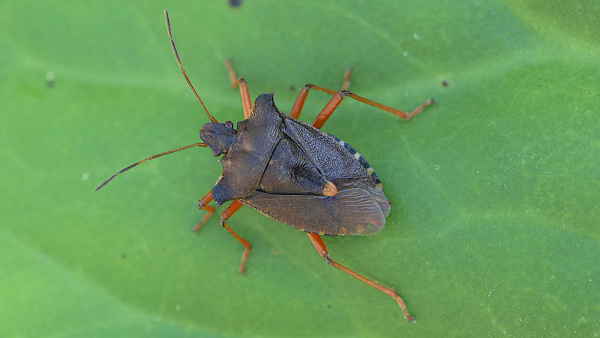
Above: A forest bug, Pentatoma rufipes. Image courtesy of user u278 on flickr
The forest bug, also known as the red-legged shield bug is a true bug – a member of the order hemiptera, characterised by their piercing and sucking mouthparts. The forest bug uses these mouthparts to drink the sap of trees, preferring deciduous trees, such as oak, alder and hazel. While their diet is predominantly sap, they have been known to explore other food sources, some being partly predatory, feeding on caterpillars and other soft-bodied insects, and some preferring to feed on fruits. Because of this, they are sometimes regarded as a pest by farmers and gardeners, as the damage caused by feeding on developing buds, flowers and fruit can cause pitting, distortion and other imperfections in the fruit.
The forest bug can be distinguished from other shield bugs by the shape of its shoulders, which are square-cut and rounded at the front, and by the colour of its legs and antennae, which vary in colour from orange to deep red.
6. Red wood ant – Formica rufa
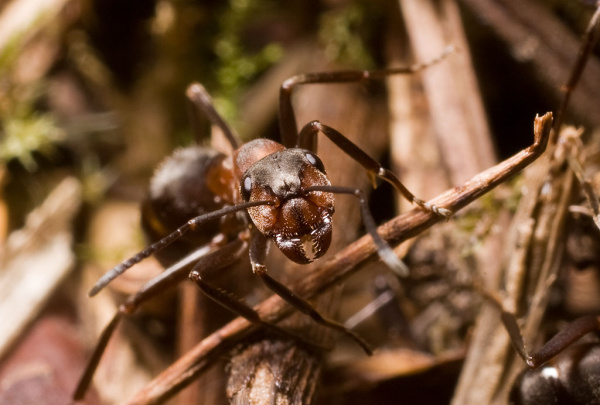
Above: A red wood ant is sizing up the photographer. Image courtesy of flickr user David Evans.
Widespread across Europe, the red wood ant will happily inhabit a variety of woodland habitats, including deciduous, coniferous and mixed woodland. They can be quite a conspicuous resident due to the large mound nests that they build above the ground, which can reach over a metre tall. These nests are made up of large hills of leaves and twigs, and often can be heard before they are seen.
This species can be polygynous – having multiple queens per colony, sometimes as many as 100, and polydomous – having multiple nests per colony, creating vast networks throughout a woodland. Colonies can have several hundred thousand individuals, and this many ants require a lot of food! Workers can be found foraging up to 50m away, which is a very long way when you’re only 9mm long! That’s the equivalent of a human travelling for over 90km – about the distance between our head office in Coalbrookdale near Telford, and the Welsh office in Machynlleth in the West of Wales!
As with the speckled wood butterfly, the main diet of the red wood ant is made up of honeydew secreted by ants. But rather than just collecting it, the ants actually farm the aphids, stroking aphid abdomens with their antennae to stimulate honeydew production. In return, the aphids get protection from predators, so it’s a win-win situation! With their voracious appetites, a single colony of ants can consume up to a quarter of a tonne annually! But as if that weren’t enough, wood ants are also excellent predators, feeding on other insects and invertebrates whenever the opportunity arises.
So, next time you’re in the woods, why not keep an eye out for these amazing ants! But be careful – when wood ants feel threatened they’re capable of squirting formic acid up to 12 cm into the air! (Don’t worry really, just wash it off if it gets in your eyes!)
7. European stag beetle - Lucanus cervus
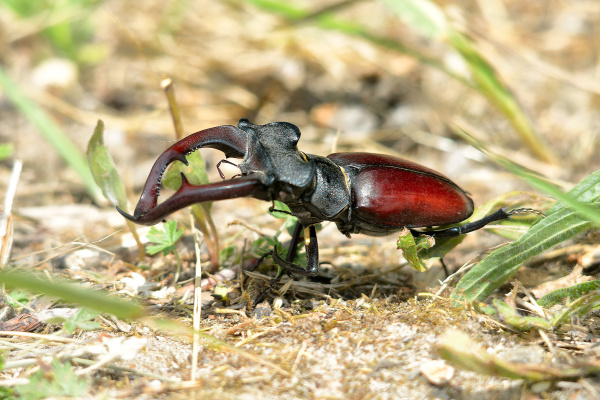
Above: The UK's largest beetle: the stag beetle. Image courtesy of user Peter Drach on flickr.
Europe’s largest beetle at up to 7.5cm long, the stag beetle is an illustrious inhabitant of oak woodlands in the South and South East of England. These beetles exhibit striking sexual dimorphism – males and females have very different morphologies, with males being larger and possessing those characteristic antler-like jaws that earn the species its name. Males use their jaws for fighting each other and for attracting a mate, but despite their fearsome appearance, stag beetle jaws are actually quite weak, and they are unable to do any damage to humans.
While the adults are around for only a few months, appearing in May and dying off after mating in August, the larvae are much longer-lived, living for up to 6 years before they pupate. They spend this time in fallen trees, logs and around tree roots, feeding on decaying wood. Because of this long life cycle, stag beetles are particularly vulnerable to habitat destruction.
If you’re lucky enough to encounter a stag beetle, you may hear it before you see it, as they are strong but noisy flyers. They tend to fly at dusk and are attracted to lights, making them vulnerable to being killed on roads when they fly towards car headlights.
Stag beetles are protected in the UK under the 1981 Wildlife and Countryside Act and are a priority species for conservation under the UK post-2010 Biodiversity Framework. This protection seems to be doing its job, as after decades of decline, their numbers seem to be stabilising. If you own or manage a woodland, a simple way to help woodland insects like stag beetles is to ensure you leave plenty of fallen and dead wood around, as so many species depend on this for food and habitats.
We hope you've enjoyed learning about woodland insects and have developed an appreciation for the dizzying diversity of insects. To learn more about insects and Insect Week, visit www.royensoc.co.uk and www.insectweek.co.uk.